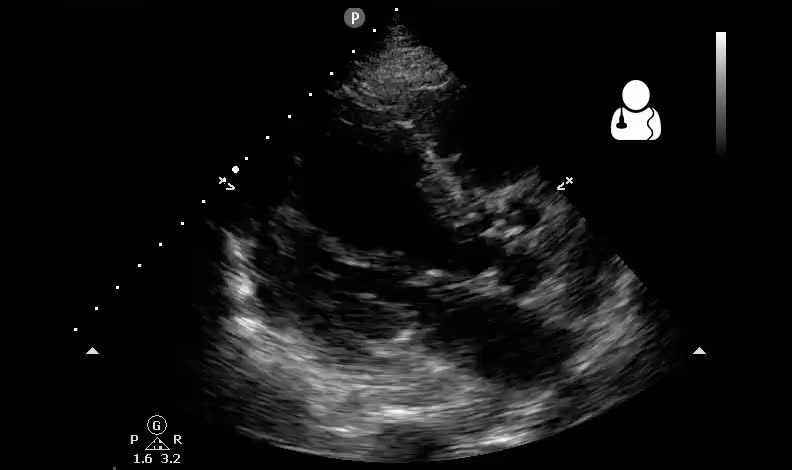This 56 year old male presents with right sided hemiparesis and expressive aphasia. What finding here could be the origin of these symptoms?

Answer: Left Ventricular Aneurysm (LVA)
This bedside echo reveals a heart that has a normal left ventricular ejection fraction, no pericardial effusion, and a normal LV:RV ratio. However, when the probe is aimed anteriorly on the apical and PLAX views, there appears to a be a large left ventricular out-pouching consistent with a ventricular aneurysm. Based on this study, it was suspected that the origin of the patient’s embolic CVA was a mural thrombus originating from this LVA.
- LVA patients will often present to the ED with chest pain, dyspnea or a clinical picture of CHF.1
- It is critical to differentiate LVA from LV pseudo-aneurysm. LVAs are characterized as a focally dilated dyskinetic area of myocardium, whereas a pseudo-aneurysm is an LV free wall rupture with blood present outside – a visualized discontinuity in the myocardium is diagnostic. While LVA patients may be symptomatic, their management is typically not emergent. Pseudo-aneurysms need emergent repair.1,2
- The most common location for LVA is the LAD region myocardium, most often in the LV anterior wall. 5% of patients post-MI will develop an LVA.3,4
- Most post-infarction LVA are apparent prior to hospital discharge.5 One prospective study of post-infarction patients showed that all LVAs were formed within 3 months of the acute event.6
- About half of LVAs have been shown to have mural thrombus, with embolism occurring in about 5% of LVA patients.7
- Because a symptomatic LVA is outside the typical critical findings to be identified on bedside echo, if an LVA is suspected, most guidelines suggest that a comprehensive echocardiogram be performed in consultation with cardiology.8
- Bailey S, Herring A, Stone M, Nagdev A. Focused Cardiac Ultrasound for the Detection of a Ventricular Aneurysm. WestJEM. 13(4):326-328. 2012. [PDF]
- Zoffoli G, Mangino D, Venturini A et al. Diagnosing left ventricular aneurysm from pseudo-aneurysm: a case report and a review in literature. J Cardiothorac Surg. 4(1):11-. 2009. [article]
- Napodano M, Tarantini G, Ramondo A. Myocardial abnormalities underlying persistent ST-segment elevation after anterior myocardial infarction. Journal of cardiovascular medicine (Hagerstown, Md.). 10(1):44-50. 2009. [pubmed]
- Mörner S, Johansson B, Henein M. Arrhythmogenic left ventricular apical aneurysm in hypertrophic cardiomyopathy. International journal of cardiology. 151(1):e8-9. 2011. [pubmed]
- Friedman BM, Dunn MI. Postinfarction ventricular aneurysms. Clinical cardiology. 18(9):505-11. 1995. [pubmed]
- Visser CA, Kan G, Meltzer RS, Koolen JJ, Dunning AJ. Incidence, timing and prognostic value of left ventricular aneurysm formation after myocardial infarction: a prospective, serial echocardiographic study of 158 patients. The American journal of cardiology. 57(10):729-32. 1986. [pubmed]
- Reeder GS, Lengyel M, Tajik AJ, Seward JB, Smith HC, Danielson GK. Mural thrombus in left ventricular aneurysm: incidence, role of angiography, and relation between anticoagulation and embolization. Mayo Clinic proceedings. 56(2):77-81. 1981. [pubmed]
- Labovitz AJ, Noble VE, Bierig M et al. Focused Cardiac Ultrasound in the Emergent Setting: A Consensus Statement of the American Society of Echocardiography and American College of Emergency Physicians. Journal of the American Society of Echocardiography. 23(12):1225-1230. 2010. [PDF]




